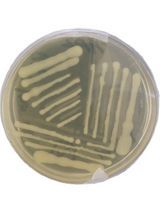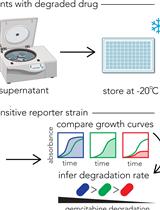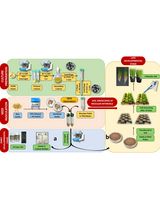- EN - English
- CN - 中文
A Guideline for Assessment and Characterization of Bacterial Biofilm Formation in the Presence of Inhibitory Compounds
抑制化合物存在时细菌生物膜形成的评估和表征指南
发布: 2023年11月05日第13卷第21期 DOI: 10.21769/BioProtoc.4866 浏览次数: 1935
评审: Emilia KrypotouElizabeth LibbyEsteban Paredes-Osses

相关实验方案

将Miniprep制备的大肠杆菌K12菌株质粒DNA转化为可用于植物遗传转化的根癌农杆菌EHA105细胞的简单可靠方法
Beenzu Siamalube [...] Steven Runo
2025年01月05日 1444 阅读
Abstract
Campylobacter jejuni, a zoonotic foodborne pathogen, is the worldwide leading cause of acute human bacterial gastroenteritis. Biofilms are a significant reservoir for survival and transmission of this pathogen, contributing to its overall antimicrobial resistance. Natural compounds such as essential oils, phytochemicals, polyphenolic extracts, and D-amino acids have been shown to have the potential to control biofilms formed by bacteria, including Campylobacter spp. This work presents a proposed guideline for assessing and characterizing bacterial biofilm formation in the presence of naturally occurring inhibitory molecules using C. jejuni as a model. The following protocols describe: i) biofilm formation inhibition assay, designed to assess the ability of naturally occurring molecules to inhibit the formation of biofilms; ii) biofilm dispersal assay, to assess the ability of naturally occurring inhibitory molecules to eradicate established biofilms; iii) confocal laser scanning microscopy (CLSM), to evaluate bacterial viability in biofilms after treatment with naturally occurring inhibitory molecules and to study the structured appearance (or architecture) of biofilm before and after treatment.
Keywords: Biofilm assay (生物膜测定)Background
Biofilm formation is considered to be important for the survival and transmission of bacterial pathogens to humans where they are able to cause disease [1]. Inhibition of bacterial biofilms by naturally occurring compounds such as polyphenols, essential oils, and D-amino acids [i.e., serine (D-Ser)] has been previously investigated [2–6] using several methods, such as spectrophotometric or fluorescence-based methods, to quantify total formed biofilms [7–9]. The most common system used to assess biofilm formation is a spectrophotometer, as it does not require overly specialized or expensive equipment, a great quantity of analytical reagents, or a high level of user expertise. This protocol presents a proposed guideline for consistent and reproducible analysis of biofilm formation in the presence of naturally occurring inhibitory compounds using Campylobacter jejuni as a model organism.
C. jejuni presents itself as a suitable model for this method as it is an opportunistic pathogen widely believed to be responsible for most cases of bacterial gastroenteritis worldwide. C. jejuni is a common commensal bacterium of poultry, especially chickens [10, 11], and has been reported to be able to form mono-species biofilms and to integrate into composite biofilms with other bacterial species, such asPseudomonas aeruginosa[8, 12–18]. The ability of Campylobacter to form biofilms plays a critical role in its survival in the environment as well as in the dissemination of infection and the emergence of antibiotic resistance [19–23].
Materials and reagents
Materials
Media: Mueller-Hinton agar/broth (MHA/MHB) (Thermo Fisher Scientific, catalog number: CM0337) and Luria-Bertani broth (LB) (Oxoid, catalog number: CM0996B)
Antibiotic stock: Trimethoprim (2.5 μg/mL) (Sigma-Aldrich, catalog number: T7883-5G) and Vancomycin (10 μg/mL (Sigma-Aldrich, catalog number: 1709007)
Strains: Campylobacter jejuni NCTC 11168-O [24] and Pseudomonas aeruginosa PA0-1
Culture conditions: cultures ofC. jejuniare grown microaerobically (85% N2, 10% CO2, and 5% O2) at 42 °C for 36 h while Pseudomonas aeruginosa is grown aerobically at 37 °C for 24 h
Chemicals: natural compounds that have high anti-biofilm properties such as D-serine (D-Ser) (Sigma-Aldrich, catalog number: S4250)
Phosphate-buffered saline (PBS, pH 7.4) (Sigma-Aldrich, catalog number: P4417)
Multi-channel pipette (e.g., 100–200 μL, 300–1,000 μL) (Thermo Scientific, catalog number: 4661180N)
15 mL conical tubes or glass test tubes for growing liquid cultures (Thermo Scientific, catalog number: 339650)
24- or 96-well clear flat-bottom plates (Geiner Bio-One, catalog number: 655101)
Tray or box slightly larger than a 96-well plate (e.g., tray dimension ~200 mm × 100 mm)
0.1% Crystal violet solution (0.1 g of Crystal violet in 100 mL demineralized water) (Sigma-Aldrich, catalog number: 548-62-9)
Modified biofilm dissolving solution (MBDS) [sodium dodecyl sulfate (SDS) (Sigma-Aldrich, catalog number: 436143) dissolved to a final concentration of 10% with 80% Ethanol in H2O) [25]
Paper towels
Large beaker
For confocal laser scanning microscopy (CLSM):
6-well polystyrene clear flat-bottom plates (Geiner Bio-One, catalog number: 655101)
Glass coverslips (e.g., 22 mm2 coverslips)
Glass slides
5% formaldehyde solution (in distilled H2O)
4′,6-diamidino-2-phenylindole (DAPI) (Sigma-Aldrich, catalog number: D8417)
Mounting medium (Ibidi GmbH, catalog number: 50001)
Nail varnish
CLSM (Nikon Microscopy, model: Nikon A1R+)
Equipment
Plate reader (Tecan, model: Infinite M200 Pro) for measuring optical density (OD) range at 570–600 nm
Incubator (SHEL LAB, model: SM12)
Laminar flow cabinet (ESCO, model: AHL-4A2)
Software
ImageJ analysis software (National Institutes of Health, Bethesda, MD, USA)
Procedure
文章信息
版权信息
© 2023 The Author(s); This is an open access article under the CC BY-NC license (https://creativecommons.org/licenses/by-nc/4.0/).
如何引用
Elgamoudi, B. A. and Korolik, V. (2023). A Guideline for Assessment and Characterization of Bacterial Biofilm Formation in the Presence of Inhibitory Compounds. Bio-protocol 13(21): e4866. DOI: 10.21769/BioProtoc.4866.
分类
微生物学 > 微生物生物膜 > 生物膜培养
生物科学 > 生物技术 > 微生物技术
您对这篇实验方法有问题吗?
在此处发布您的问题,我们将邀请本文作者来回答。同时,我们会将您的问题发布到Bio-protocol Exchange,以便寻求社区成员的帮助。
提问指南
+ 问题描述
写下详细的问题描述,包括所有有助于他人回答您问题的信息(例如实验过程、条件和相关图像等)。
Share
Bluesky
X
Copy link










